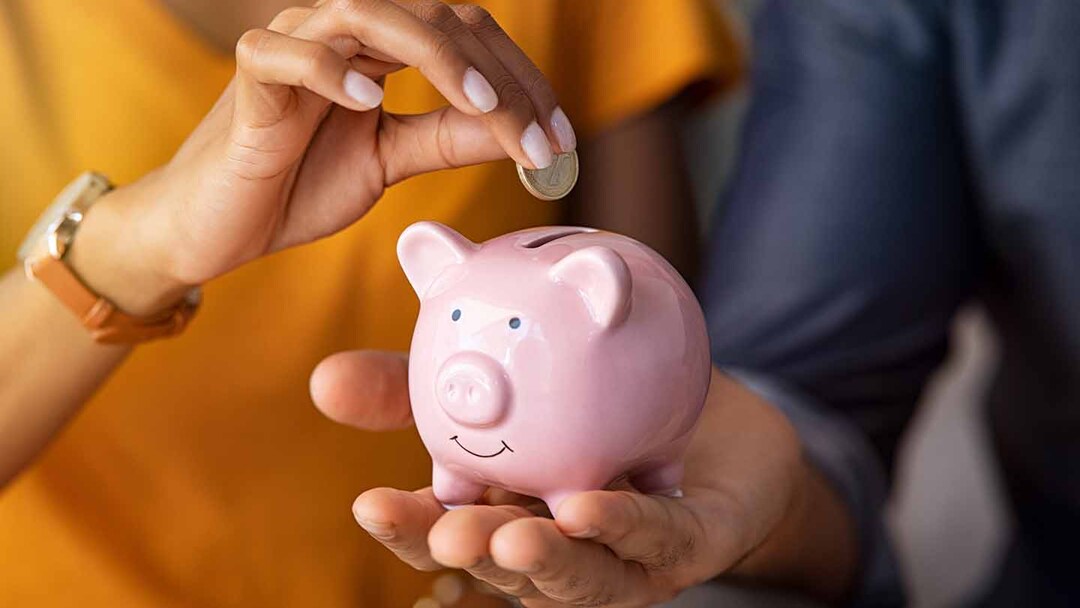How to save money: 14 tips

Knowing how to save money each month may be a challenge. Although inflation and rising prices may make saving money more difficult, you may still be able to find ways to save.
To save effectively, it’s important to have goals, a monthly budget and a plan to stay on track. Consider these tips to help you put more money away while staying on track with bills and necessary purchases.
14 ways to save money
There are several ways to save money even in a tight economy. Some approaches rely on planning ahead to keep costs down, whereas others are a matter of knowing which financial tool to use at the right time. This article touches on each of these 14 tactics below:
- Set specific savings goals
- Create a monthly budget and stick to it
- Bring a shopping list to the store
- Try using cash for everyday purchases
- Know when to use a debit card or a credit card
- Review your subscriptions
- Switch your cell phone plan
- Reduce your electric bill
- Reduce your basic living costs
- Make the most out of your savings account
- Save unexpected or extra money
- Pay off your debts
- Set aside money for an emergency fund
- Contribute to a retirement savings plan
1. Set specific savings goals
Building savings during a difficult economic period can be made tougher without a financial goal in mind. If you can anchor your savings efforts to a specific goal, such as a down payment on a new car or building your emergency fund, you may help motivate yourself to stay on track. Plus, if you have a specific number in mind for your goal, you may adjust your savings efforts to match it. This may help right-size the amount you want to set aside.
2. Create a monthly budget and stick to it
Once you have specific financial goals in mind, it may be useful to set a budget to follow through on them. A monthly budget may help you better understand how your personal finance decisions affect your overall cash flow. By creating and sticking to a budget, you can track spending habits and potentially limit the number of impulse buys you make per month. A budget may help you avoid splurge purchases and track how much income you can put into savings every month. Consider using a budgeting app to help you automate your savings, understand your spending and reach your goals.
3. Bring a shopping list to the store
Shopping lists are great at helping us remember what we need to buy, as well as helping us limit impulse purchases. Many retailers, including your local grocery store, are designed to encourage one-off or impulse purchases. Although one or two impulse purchases may not seem like a lot of money on their own, they may add up over time.
Think of your shopping list as an extension of your budget: what you put on your list should be determined by your budgeting, keeping your budgeting on track in the process.
4. Try using cash for everyday purchases
When you pay in cash, you’re better able to see the actual financial impact of your purchases in realtime. Credit cards, by contrast, may make overspending easier because they're not physical currency. If you bring cash with you to the store, you’re physically limited by how much you have on hand. This may help you stick to your budget and stay honest with your shopping list.
5. Know when to use a debit card or a credit card
Using cash isn’t always feasible, of course. There are some transactions, either online or in cashless stores, that require a card. Using your debit card when cash isn’t an option may help you be more cognizant of your spending. A credit card may enable you to overspend since you’re charged once a month; debit cards, however, require you to have the funds on hand for the transaction to go through.
Depending on your bank checking account, your card might be declined at the point of purchase if you don’t have enough funds. Alternatively, you might see the transaction go through if you have overdraft protection. These protections may come at a cost, though, by way of fees.
When making online purchases, keep in mind that credit cards will generally have stronger fraud protections than debit cards. Using credit and debit cards in an informed way may help you stay on budget and protect your finances from fraudsters.
6. Review your subscriptions
Subscription services, such as streaming services or publications, may eat away at your cash — often without you realizing it. Services that charge you monthly may go unnoticed, particularly if monthly fees are low. Over time, these small expenses may add up.
If you subscribe to publications, services or entertainment platforms you don’t use often, consider canceling them. This may be an easy way to free up cash every month, particularly if you aren’t missing what they have to offer or have stopped using them. If you’re not sure canceling is the right option, consider downgrading your subscription to a less expensive option.
There are a few ways you may identify and cancel subscriptions you no longer need. The first is by reviewing your bank or credit card statements. Some apps may help you keep track of and cancel subscriptions, but these may come with fees.
7. Switch your cell phone plan
Cell phone service is an essential expense for most of us, although you don’t always have to pay a high price for good service. Some of the country’s largest networks are also the most expensive: these companies reinvest in new cell towers and other costs that make their way onto your monthly bill. Others may tout unparalleled service, charging you a premium in the process.
If you want to lower your cell phone bill, there are a few options to consider. First, check with your provider to determine whether a lower-tier plan is available. Expensive unlimited data plans may not be ideal for people who only use a few gigabytes of data every month.
If a lower-tier plan is not available, consider switching providers.
Last, consider using secure Wi-Fi whenever possible. Safe Wi-Fi networks provide speed and flexibility with what you download and how much data you use. If you know you’ll usually be in areas where secure Wi-Fi is available, you may not need to buy a plan with a high data cap.
8. Reduce your electric bill
Some electricity costs are unavoidable, but cutting back may go a long way in many places. Keeping your thermostat lower in the winter and higher in the summer may result in lower monthly bills. Smart meters may help you regulate when and how much air conditioning and heating you use as well.
Some power companies and state governments offer incentives for going green. Your utility company may offer free or low-cost energy audits, which may help you create a more energy-efficient home.
Lastly, try to turn off appliances when they’re not in use. Smart sockets may help you set timers that turn off appliances, lights and other energy-consuming appliances.
9. Reduce your basic living costs
We may take living costs for granted: after all, studies have shown that “lifestyle creep” is a common phenomenon for many. It’s easy to spend more when you have more money. This doesn’t work as well when internal and external factors require you to scale back on life’s essentials.
Depending on where you live, you may be able to afford a different lifestyle; when planning for the long term, consider a cost of living comparison. High-priced neighborhoods and cities may charge you a premium you could avoid by moving farther away. Be aware that this might also require you to spend more in other places, such as a monthly train ticket or gas for your car.
If you own a home, car or both, you may want to refinance these loans at a lower rate. If you’re paying more than the average interest rate on a mortgage or auto loan, refinancing may save you money over time, while reducing your monthly payments. Take a close look at your insurance policies as well, as you may be overpaying for your coverage. Many providers offer a discount for bundling home and car insurance, which may save you money every month.
10. Make the most of your savings account
Understanding the nuances of different types of bank accounts may help you save money in the long run. High-yield savings accounts offer high interest rates, usually in exchange for limited monthly transactions. A more conventional savings bank account could come with a lower interest rate but more flexibility with withdrawals and deposits. A certificate of deposit (CD) account may earn you even more interest, but most restrict you from withdrawing money for a certain period of time.
When you link a checking and savings account, you may make it easier to factor savings into your budget. Recurring automatic transfers may give you the peace of mind that you're making payments on time, while saving towards your goals.
Some employers may even let you divide your direct deposit payments into two or more accounts. With this method, you can determine how much to put in savings right from your paycheck.
11. Save unexpected or extra money
If you’re fortunate enough to come into unexpected money, be it from a bonus at work, tax refund or inheritance, consider setting it aside as savings to help you save more money in the long run. The more you put in a savings account or CD, the more you’ll benefit from compounding interest.
12. Pay off your debts
Some forms of debt, such as credit card debt, may have higher interest rates than others, like student loans. Depending on your situation, you might choose to pay off high-interest debt first or to pay off your smallest debts first. Both strategies have their own benefits and drawbacks. Either way, strategically tackling monthly payments on your debt may free you up to save money in the long run.
13. Set aside money for an emergency fund
Emergency funds are essential since they may help you pay for critical goods and services when you might otherwise have to take on debt to afford them. An emergency fund supplies you with a financial cushion should something unforeseen happen; a general rule is to have enough to cover three to six months' worth of expenses. With an emergency fund, you may earn interest on your balance while taking comfort in your financial strength in the face of a crisis.
14. Contribute to a retirement savings plan
Retirement savings plans, such as an individual retirement account (IRA) or 401(k), may provide you with tax-advantaged ways of saving for retirement. Depending on the kind of retirement plan you choose, you can opt to either pay taxes on your contributions up-front or when you start to withdraw funds from these plans in retirement.
Early withdrawals from retirement plans may come with financial penalties, so it's important to understand all your options before withdrawing funds.
Employers might offer common plans, such as a 401(k) or 403(b) for certain public or nonprofit employers. Employer plans generally allow you to make contributions from pre-tax dollars directly from your paycheck. Your employer may even "match" your contributions up to a certain percentage of your paycheck.
(401)k accounts use pretax income for long-term investments. Since your investment dollars aren’t taxed as income when you invest, you pay tax on what you withdraw instead. Roth IRAs, on the other hand, use post-tax income for investment funds. In this scenario, you’ve already paid taxes on the money you've saved.
Ready to save?
Saving for the future may not be easy, especially during economic uncertainty, but it’s an essential part of any successful personal finance plan. The more you save, the more prepared you may be when the unexpected happens. Whether you’re new to saving or looking to adapt in the face of economic headwinds, it’s important to know your options.
These tips on how to save money are only the beginning. Reach out to a financial professional for more information about personal banking solutions and other tools to keep your savings on track.



